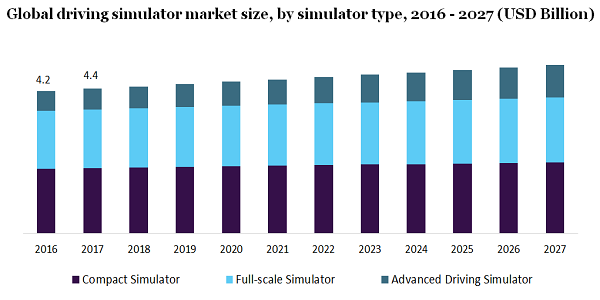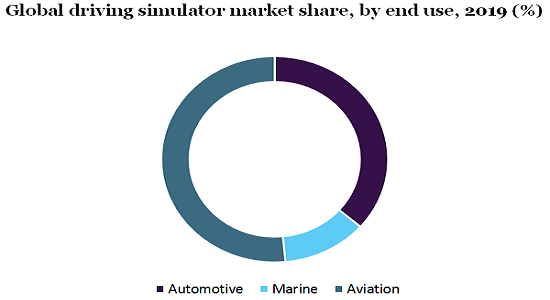- US: +1-408-610-2300
- Toll Free: +1-866-831-4085
- Become a Client
The global driving simulator market size was USD 4.6 billion in 2019. It is projected to register 3.4% CAGR from 2020 to 2027. The emergence of autonomous vehicles worldwide is a key factor driving the growth of the market. The use of innovative components such as processors and sensors has gained traction in the automobile in the recent past. In order to test the performance and abilities of these components, automotive original equipment manufacturers are increasingly using driving simulators.

With the growing popularity of Advanced Driving Assistance Systems (ADAS), demand for several innovative features such as blind-spot monitors, collision avoidance systems, adaptive cruise control, and automatic parking has increased in the past few years. OEMs across the globe are emphasizing improving these technologies to do away with possible glitches. Thus, the ADAS system is tested using driving simulators as it offers a realistic view of the overall vehicle performance.
The use of advanced driving simulators is gaining traction among automakers owing to their superior testing abilities. These testing technologies are witnessing several advancements such as extensive motion capabilities, the formation of clear images, and quality control loaders. However, the high cost of machines coupled with improper infrastructural development in emerging countries is estimated to hinder market growth.
The use of simulators is popular in both the aviation and marine industries. Flight simulators are used to offer a real-time driving experience for pilots along with training crewmembers. For both commercial and military aircraft training, flight simulators are being used increasingly. Simulators help in providing adequate skills to the drivers to handle critical situations, thereby, minimizing the risk for passengers. Therefore, increased passenger safety and the low cost incurred in training are bolstering the growth of the driving simulator market.
On the basis of the simulator, the market is segregated into full-scale, advanced driving simulators and compact. Of them, the compact category accounted for the largest share by revenue in the market in 2019. Further, the segment is projected to continue its domination over the forecast duration. Owing to their small sizes, these kinds of driving simulators are used for several applications including bikes, cars, buses, and trucks. In addition, these simulators are cost-effective and are extensively used in driving training institutes.
On the other hand, the advanced simulator category is projected to grow at the highest CAGR over the forecast duration. These simulators offer advanced features like motion platform and 360-degree viewing angle, thus, offering a realistic experience to users. In addition, these simulators are gaining traction among automotive OEMs as they are used in testing advanced features such as braking, aerodynamics, acceleration, braking, and steering.
By application, the market is segmented into training, motorsports & gaming, and research & testing. In 2019, the research and testing category accounted for the largest share in the market. Further, the segment is projected to witness maximum growth from 2020 to 2027. The emergence of autonomous vehicles is driving the growth of this segment. The investment in research and development has intensified as OEMs are aggressively focusing on making autonomous driving a reality. Driving simulators help in testing the performance of such vehicles in real-time, thereby, augmenting the market growth.
On the other hand, in 2019, the training division accounted for a noticeable market share. The use of driving simulators for the basic driving lesion is popular across training institutes. Driving simulators help drivers in countering different challenges under a controlled environment. In addition, it helps the driver with advanced skills including operating the vehicle efficiently under extreme environmental conditions.
By end-use, the driving simulator market is categorized into marine, aerospace, and automotive. In 2019, the automotive category accounted for a significant share in the market. Growing penetration of both commercial and passenger vehicles across the globe is driving the growth of this segment. Nearly 70 million units of passenger vehicles were produced in 2018, as estimated by the International Organization of Motor Vehicle Manufacturers (OICA).
Further, automotive OEMs such as Tesla, Honda, Toyota, and BMW are significantly investing in research and development to improve the model of their existing cars. These OEMs utilize driving simulators to test the performance of their vehicle in real-time. Driving simulators are equipped with different components to mimic the real-time environment, thus making the testing effective.

Further, airline companies are increasingly adopting driving simulators at their training centers and aviation schools. The use of flight simulators is popular for military aircraft, unmanned aerial vehicles, commercial helicopters, and aircraft. The rapid influx in air traffic has resulted in an increase in demand for trained commercial pilots, thereby, augmenting the use of driving simulators.
Key aviation market players such as Airbus and Boeing are significantly investing in advancing their training facilities. In addition, these players offer simulator services to both commercial and non-commercial users, thereby, proliferating the market growth.
In 2019, Europe accounted for the largest share in the market, and the region is predicted to hold its dominance from 2020 to 2027. Increasing demand from Germany and the U.K. is driving the growth of the region. Especially, Germany, which is the hub for leading automobile manufacturers like Porsche, Audi, Mercedes, and BMW, is attributing to the market growth owing to the increasing demand from the automobile industry. Moreover, key OEMs use driving simulators for testing the performance of their vehicles and design enhanced in-vehicle technologies.
The Asia Pacific is predicted to witness the fastest growth rate from 2020 to 2027 owing to the increasing spending on research and development in the automotive sector. Countries like China, India, and Japan are attracting some of the world’s leading automobile manufacturers. For example, Volkswagen opened its research and development facilities in the Indian city Pune in January 2019. Several other companies are following similar suits. Thus, the rapidly growing automobile sector is estimated to bolster the growth of driving simulators.
The outbreak of COVID-19 has negatively affected the growth of the market. Following the outbreak, several end-user industries such as automotive, aviation, and marine were forced to stop their operations. To control the spread of COVID-19, these industries also debarred their training facilities, as social distancing is imperative. In addition, COVID-19 has adversely affected the companies’ revenue and countries’ economy. Low demand for driving simulators resulted in considerably low spending on research and development, thereby, hampering the market growth.
Leading players operating in the industry are CAE, Inc., Anthony Best Dynamics Limited, L3 Technologies Inc., Bosch Rexroth AG, and Thales Group. These players focusing on various strategic initiatives to increase their market share. Various strategic initiatives include mergers and acquisitions, partnerships, and new product launches. For example, Bosch Rexroth in February 2018 introduced a motion platform. This platform has a rotating yaw table, liners motor, and a hexapod. Considering the intense competition, other market players are also following similar suits.
|
Attribute |
Details |
|
The base year for estimation |
2019 |
|
Actual estimates/Historical data |
2016 - 2018 |
|
Forecast period |
2020 - 2027 |
|
Market representation |
Revenue in USD Million & CAGR from 2020 to 2027 |
|
Regional scope |
North America, Europe, Asia Pacific, Latin America, and MEA |
|
Country scope |
U.S., Canada, U.K., Germany, France, China, India, Japan, Brazil, and Mexico |
|
Report coverage |
Revenue forecast, company share, competitive landscape, growth factors, and trends |
|
15% free customization scope (equivalent to 5 analysts working days) |
If you need specific information which is not currently within the scope of the report, we will provide it to you as a part of the customization |
This report forecasts revenue growth at global, regional, and country levels, and provides an analysis of the latest industry trends in each of the sub-segments from 2016 to 2027. For the purpose of this study, Million Insights has segmented the global driving simulator market report based on simulator type, application, end-use, and region:
• Simulator Type Outlook (Revenue, USD Million, 2016 - 2027)
• Compact
• Full-scale
• Advanced
• Application Outlook (Revenue, USD Million, 2016 - 2027)
• Research & Testing
• Training
• Motor Sports & Gaming
• End-use Outlook (Revenue, USD Million, 2016 - 2027)
• Automotive
• Marine
• Aviation
• Regional Outlook (Revenue, USD Million, 2016 - 2027)
• North America
• The U.S.
• Canada
• Europe
• The U.K.
• Germany
• France
• The Asia Pacific
• China
• India
• Japan
• Latin America
• Brazil
• Mexico
• Middle East and Africa (MEA)


Research Support Specialist, USA